Last Updated: August 18, 2022
Poas Volcano is one of Costa Rica’s most iconic volcanoes. At almost a mile (1.5 kilometers) wide and 900 feet (300 meters) deep, this crater volcano is surely impressive. Every day, droves of people head to Poas to try to catch a glimpse of the glorious crater and its blue-green lake. But what many people do not know is that it is actually not that easy to see. Often, the volcano is hidden behind a thick layer of clouds. Moreover, due to current protocols, visits must be planned in advance and the time you can spend at the crater is limited.
In this post, we’ll give current information about visiting Poas Volcano. We’ll include how to reserve tickets, current safety protocols, and what you can expect to see.
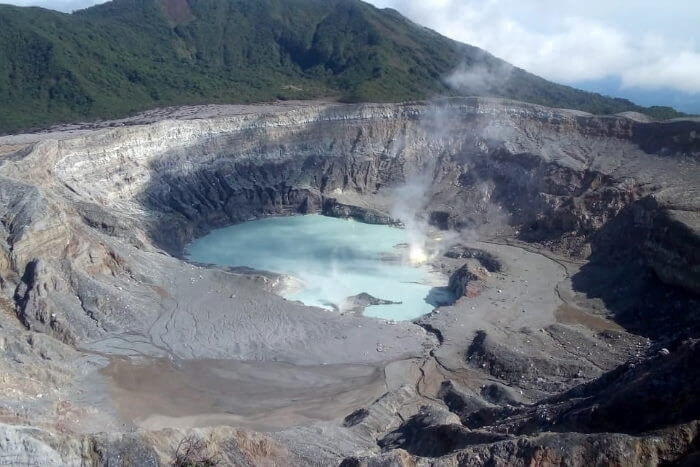
Background
Poas Volcano is located in the mountains north of the capital city of San Jose. Although it looks fairly close on a map, it is still about a one-hour drive due to road conditions. The roads leading to Poasito, where Poas Volcano National Park is located, are slow and steep.
Because of its relative proximity to San Jose, Poas Volcano is a popular destination. Tourists come from San Jose looking for a day trip and locals head to Poas to get out of the city. It’s a big stop for tour companies as well, and you will often see large tour buses in the parking lot.
Tip: Although you can easily visit Poas Volcano on a day trip, it is worth spending a few days in the area. Poasito and the nearby town of Vara Blanca are very charming, with rolling green mountains, strawberry farms, waterfalls, and coffee tours.
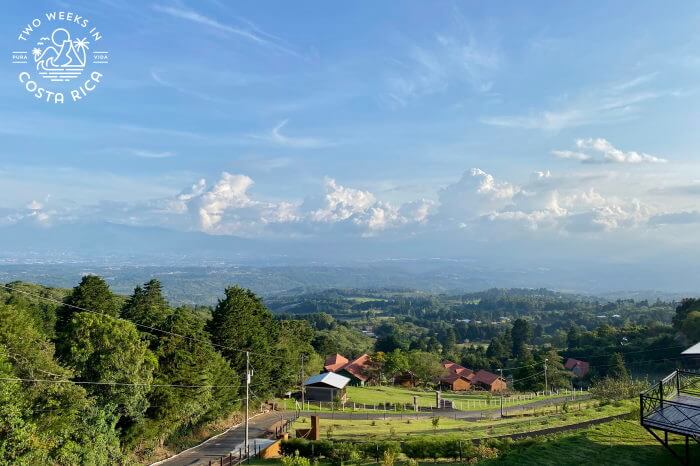
Background on Poas Volcano
Volcanic Activity
Poas is an active volcano (a complex stratovolcano) that is about 600,000 years old. It has been making headlines for the last several years with its showy eruptions.
Although Poas has been active since the 1800s, its activity intensified dramatically in 2017.
In March and April 2017, the volcano experienced tectonic earthquakes, tremors, explosions (some over 500 meters/1,640 feet high!), and fumaroles (steam columns). It threw mud, ash, and gas, the lagoon changed from green to gray, and strong eruptions destroyed most of what was left of the volcano’s dome.
These eruptions led to the closure of the national park.
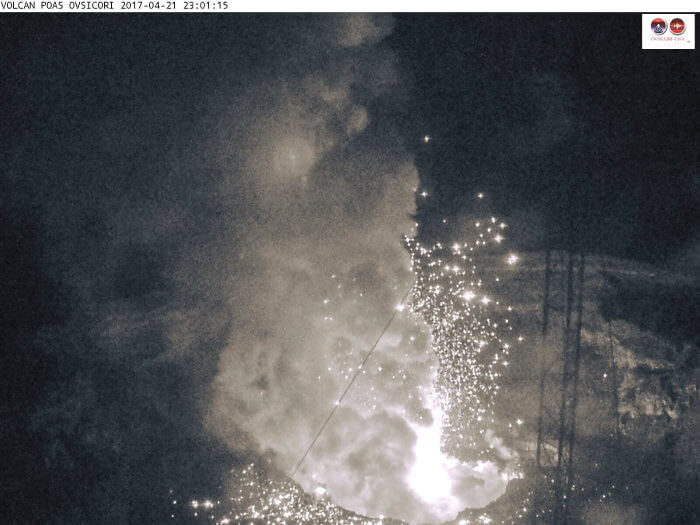
Reopening with Safety Measures
In August 2018, the park was permitted to reopen, after seismologists and health officials deemed it safe for visitors. There were a lot of changes, though.
Now, visits are much more controlled. The biggest changes are that you need to buy tickets in advance and the time you can spend at the crater is limited to 20 minutes.
Reopening of Laguna Botos Trail
Up until July 2022, all side trails at Poas Volcano National Park were closed for safety reasons. As of mid-August 2022, the Laguna Botos Trail is back open.
This is a great change as it gives visitors something else to check out if they don’t have luck seeing the crater.
Buying Tickets to Poas Volcano
To get tickets, you’ll need to go online to the SINAC government website.
First, you’ll create an account. There is a button to change the language to English.
Once you’re logged in, go to Buy on the left, then select Online Reservation.
Use the dropdowns to select Parque Nacional Volcan Poas.
Choose your date and time of visit (under Sector/Schedule). You’ll see that there are 18 timeslots in 20-minute increments. They start at 8:00 a.m. and go until 2:20 p.m.
Select the number of people, adults and children.
On the last page, you will need to fill in everyone’s full names and passport numbers, then enter your credit card information to pay. You’ll then get a confirmation, which also will be emailed to you.
At the park entrance, they will ask to see your confirmation. It’s best to have it saved to your phone in case you don’t have cell phone service at the park.
Visiting Poas Volcano – What to Expect
Arriving
When you arrive, you’ll drive up to the gated entrance where they will make sure you already have tickets. You’ll likely see people pulled over buying them on their phone who haven’t done it yet. You’ll also pay for parking ($2).
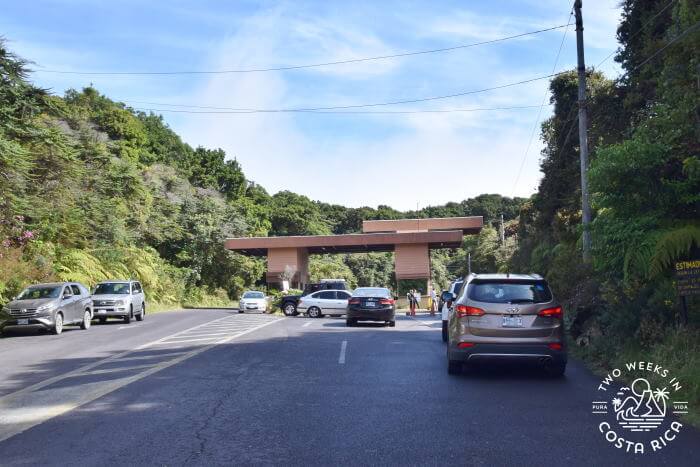
Safety Precautions
You’ll continue to the parking lot and walk to the main reception to get a hard hat.
Now, everyone has to wear a hard hat in the unlikely event of an eruption. This makes for some pretty goofy, but memorable, photos.

You’ll then join the rest of the group in the theater to watch a short video about the volcano and safety measures in place. The video is in several languages.
Near the crater are a few concrete structures in case of emergency. You’ll also notice something that looks like a traffic light. This monitors the level of volcanic gas and would change color and alarm if you needed to head to a shelter. Remember that scientists are constantly monitoring the volcano, so these are just precautions.

Walking to the Crater
Once the movie is done, a park official will escort the whole group (usually they combine multiple groups from different timeslots) to the crater.
The walk to the crater is short, only about 10 minutes, along a flat, paved path. It’s an easy walk, but because you’re at a higher altitude, the air is thinner, which can make it a little harder to breathe.
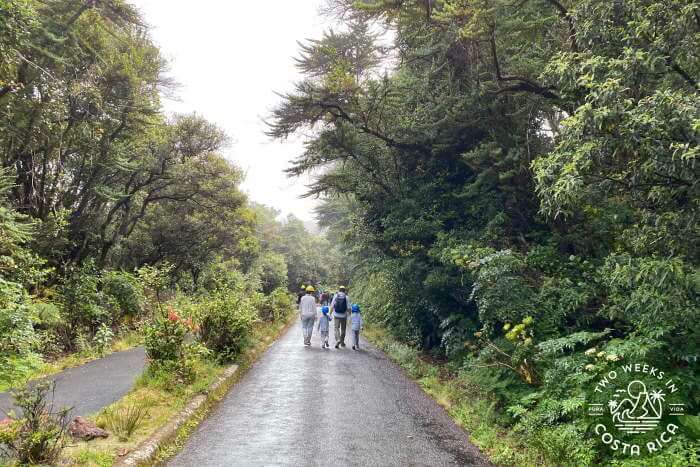
Walking even just the main trail will give you a sense of the beautiful, unique landscape.
Poas has cool temperatures (for Costa Rica), wind, and lots of moisture. The environment is different than elsewhere in the country and the ecosystem reflects this.
One noteworthy plant you’ll see is the so-called Poor-man’s Umbrella plant. These broad-leafed plants are dotted all along the trail and are so large, you could use them as an umbrella. You’ll also see lots of thick moss, vines, and epiphytes (air plants).

Arriving at the Crater
Once you get to the crater, hopefully you can peek past the barrier to get an amazing view! Since the crater is so wide, there’s plenty of space along the edges to get some good pictures.
If you aren’t so lucky and there are clouds, you can wait it out (up to the 20 minutes allowed by your tickets). The weather around Poas is constantly changing so it’s not uncommon for the crater to be clouded over one minute and perfectly visible the next.
But the reality is, it is not that easy to see the crater. We have been to Poas three times over several years and have NEVER seen the crater! We’ve visited at different times of year and in the morning when people say visibility is the best, and the crater has always been completely clouded over. Here is a link to our post, Racing the Clouds at Poas Volcano, about our first time visiting.

This is very common, and now that visits are limited to 20 minutes and you need advance tickets, it’s harder than ever to catch a glimpse of Poas Volcano.
Laguna Botos Trail
If you don’t see the crater, you also can check out the Laguna Botos Trail.
This is a short, 800 meter (0.5 mile) paved path that cuts through thick cloud forest.
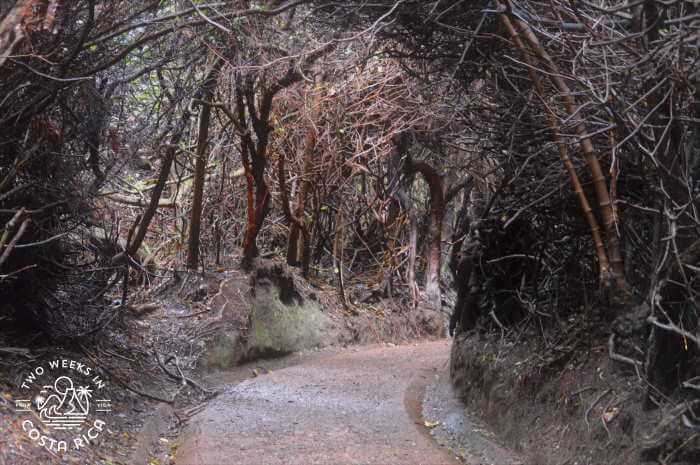
At the end of the trail, you’ll find a viewing platform overlooking Laguna Botos (Botos Lagoon). This is an extinct volcanic crater that is 400 meters (2,525 feet) wide and 14 meters (46 feet) deep. It’s covered in a pool of cold blue-green water.
If the crater was covered by clouds when you tried to see it, chances are, Laguna Botos likely will be obscured covered too. But there’s always the possibility of the clouds lifting.
Live Cam of the Crater
One really cool feature you can take advantage of is a live cam on Costa Rica’s Volcanic and Seismology Observatory’s website. This lets you see Poas’ crater in real time. Here is the link.
We spent some time watching it when working on this article and saw the crater go from full view to complete clouds over and over again!
Sometimes in a matter of 10 or 15 minutes, it can go from completely clear to completely obscured. So it’s definitely worth waiting the 20 minutes at the crater’s edge when it is your turn.
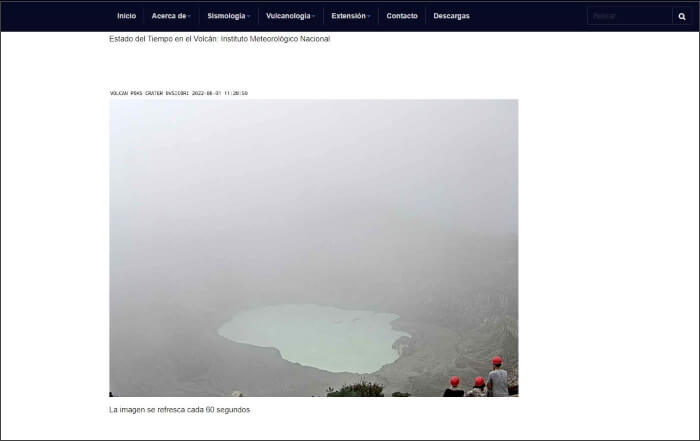
Ongoing Volcanic Activity
Poas continues to have eruptions and monitoring is ongoing. To see videos of recent activity, check out the national park’s Facebook page.
Tips for Visiting Poas Volcano
When to Go
People say that the best time to see the crater is early in the morning, so when the park opens at 8:00 a.m. We have been early ourselves, getting there before 9:00 a.m., without seeing the crater. So some of it is just luck.
Because of the new protocols with having to get a helmet and watch the movie, it takes a while to actually get to the crater so we recommend getting the earliest time slot possible if you want to be there by 9:00 a.m.
We used to think that it was easier to see during dry season (December through April) but have heard from other locals that it doesn’t really matter if you go in dry or rainy season (May through November).
The national park is busiest on the weekends and holidays.
What to Wear/Bring
Since Poas is high altitude, it is quite chilly, with temperatures around 12°-15 °C (50-60 °F).
Wear pants and dress in layers. Definitely bring a raincoat or poncho, as rain comes and goes and it’s often misty with all the clouds. If you wear glasses, opt for contact lenses that day.
Cost
Foreigners: $15 adults, $5 children ages 2-12, free for children under 2.
Citizens and Residents: 1,000 colones adults, 500 colones children ages 2-12, free for children under 2.
Visitors Center
Poas Volcano National Park now has a huge, modern visitors center. Downstairs are bathrooms and upstairs is a large cafeteria and gift shop.
The cafeteria has empanadas, croissants, breads, sandwiches, muffins, donuts, desserts, and an assortment of drinks, including specialty coffees.

Accessibility
Poas Volcano National Park is handicap accessible. A wheelchair can easily go the whole way to the crater.
Conclusion
Poas Volcano is one of Costa Rica’s most famous volcanoes, but if you’re thinking of visiting, know that there’s no guarantee you’ll actually see it. It takes a bit of time and organization to visit so may not be worthwhile for everyone. After trying to see it three times ourselves, it will probably be a while before we venture back.
Last Updated: August 18, 2022
Have you seen Poas Volcano? Any tips on how to see the crater? Leave us a comment below.
Looking for more information to plan your trip to Costa Rica? Check out these posts:
Arenal Volcano National Park – Arenal is Costa Rica’s best-known volcano. Although this cone-shaped giant also can be hidden behind the clouds, it’s a bit easier to see than Poas.
Irazu Volcano: Easy Access, Crater Views, and Extreme Climate – Irazu is another crater volcano located east of San Jose.
La Paz Waterfall Gardens: Another great attraction in the Poas area is this wildlife center and set of waterfalls.

We’ve been 5 or 6 times in the past 7 years and have seen the crater every time. I attribute that to our driver, Jorge Vasquez, who calls the park to make sure the crater is visible before we leave. If you have a clear view, you can also see Arenal Volcano in the distance.
How far in advance should one book a time? Thank you!
Hi Nadine, In high season (mid Dec. through end of April), we’d book at least a couple of weeks in advance.
Is the park closed atr the moment because of volcanic activity or is it open?
Hi Niall, They are monitoring Poas for activity but it is still open. You can still buy tickets online and they haven’t announced any closure through the national park’s official Facebook page.
Thanks for the info
Hi Jenn and Matt – would you be able to arrange a private transfer to Arenal from San Jose/Alajuela or Vara Blanca which incorporates an early morning trip to Poas too? If this is possible please could you let us know rough cost (we are a family of 4) and how we could book this with you?
Also, would the overall journey be shorter if you started from San Jose or Vara Blanca (not sure which way you’d naturally go to get to Arenal from either) Many thanks for all of your help, Karen
Hi Karen, Since Poas is not directly on the way to Arenal from San Jose Airport/Alajuela area, we would need to arrange two separate transfers for you. It would be around $202 + $94 + 8% tax. If you’re interested in booking it, you can just go through our Private Shuttle transfers page and we will get back to you by email once you make the requests.
For your second question, Vara Blanca is closer to Poas and on the way to Poas from the airport. But we don’t have a private shuttle option that would work for this. It probably makes more sense to stay near the airport and head to Poas the next day on your way to Arenal.
Thanks for this, and the honesty 🙂 What I needed to swing away 😀
How long do you think you need altogether for a visit to poas? We are planning this as a stop off on way to la paz watergardens
Hi Samantha, It only takes about an hour total – your visit time is restricted due to park rules because of the volcano being active. When you go to buy tickets, you’ll buy them for a specific time and are only allowed 20 min. at the crater. Then there’s a short video before and the short walk to and from the crater.